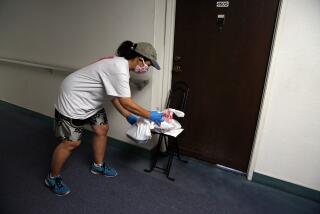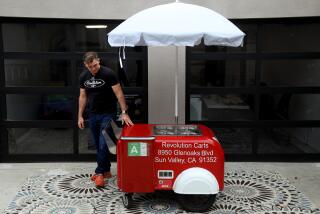Deep Freeze for Hot Lunches
Lunches used to arrive piping hot five days a week at Lodema Gartman’s doorstep. But now the 74-year-old shut-in gets a stack of frozen meals once a week -- and she’s not happy.
“I liked the hot meals better,” the rail-thin Ventura resident said recently, picking at a microwaved entree of beef stroganoff, green beans and cauliflower. “They tasted better and they were always hot.”
Citing budget constraints, Ventura County on April 1 will cease operation of its $1.4-million hot lunch program for homebound and low-income seniors. After 35 years, county cooks will no longer prepare vats of soups, stews and rice, and pans of meatloaf each morning at an industrial kitchen in Camarillo.
Instead, the county is purchasing frozen meals in bulk and paying cities and nonprofit groups to deliver stacks of entrees once a week to 1,000 isolated seniors. Ventura County is the first in California to go totally frozen, but others are switching to microwaveable meals because, in part, it’s cheaper.
Fresno County offers frozen entrees as an option, said Bob McCafferty, spokesman for the state Department of Aging. Modesto and Santa Cruz counties and parts of San Diego County are experimenting with them while Los Angeles County is sticking with hot meals for now.
Cost is a big factor, officials said. A fresh meal costs about $9 to prepare and deliver, while a frozen entree runs about $2, said Victoria Jump, executive director of the Ventura County Area Agency on Aging.
Ventura County will save about $400,000 a year by contracting out the program, Jump said. Many of the 28 workers who ran the program are expected to be rehired by cities and private agencies, but a handful will be laid off, she said.
Facing chronic budget shortfalls, the county Board of Supervisors last year asked social service administrators to find a way to make the program pay for itself. Federal funding of senior nutrition programs has remained steady but has never fully covered the cost of preparing hot meals, Jump said.
“It’s expensive for a county agency to run a program like this,” she said. “The county found that each year they were putting in more and more general fund money to support the program.”
Hot meal programs have been around for more than three decades, an offshoot of President Lyndon Johnson’s War on Poverty. Although low-income seniors are generally healthier and better fed than in previous generations, pockets of elderly who are too sick or are isolated remain. That’s where home delivery meal programs step in. Most provide shut-ins with hot meals delivered by staff or volunteers five days a week.
Advocates say the visit is an important aspect of the program because many homebound elderly have little contact with the outside world. It also serves as a convenient check on their health, said Enid Borden, executive director of Meals on Wheels Assn. of America, a Washington, D.C.-based group representing private meal providers.
“When someone knocks on that door and says, ‘How are you, Mrs. Smith?’ it sure beats not having that connection. If something’s wrong, they can summon help.”
While fresh, hot food and a daily visit are ideal, Borden said, trade-offs are inevitable in an era of tightened budgets.
“I wish we lived in a world where we had all the money we needed and could feed them three meals a day,” she said. “But that’s not the case, and we have to figure out what we can do more effectively so they at least get that one meal.”
After 27 years of preparing hot lunches for Ventura County’s seniors, cook Cathy Mix has made her last meatloaf for the program. She is one of dozens of county employees who over the years have prepared hot lunches at the Senior Nutrition Center.
On a recent day, however, the kitchen was silent as Mix and a handful of other workers heated up frozen entrees for lunch programs held at senior centers.
Those entrees scheduled for home delivery were sorted separately into stacks of five and bagged. Driver Kelvin Childs loaded the bags into a white van and began his route in Ventura.
Though other areas won’t begin getting the frozen meals until April, the county has been providing them to Ventura seniors for weeks to test the response.
Overall, it has been positive. Many recipients say they like the convenience of saving the meals for when they feel like eating. And there have been few complaints about taste, Childs said.
On a recent day, the majority of recipients seemed satisfied.
“The only thing I miss are the salads,” said Lucile Ferrie, 86. “But, overall, it’s more convenient for me because before I was always trying to work my doctor’s appointments around the delivery.”
More to Read
Sign up for Essential California
The most important California stories and recommendations in your inbox every morning.
You may occasionally receive promotional content from the Los Angeles Times.











